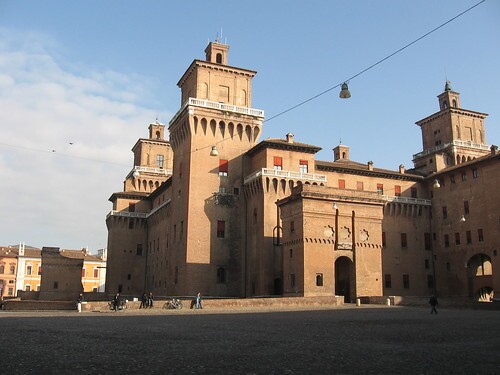Lovely Ferrara, a UNESCO World Heritage Site in the North East of Italy, did not just happen to be a beautiful city; it was planned that way! Designed to be both beautiful to look at and at the same time functional – fulfilling the Humanist concept of the “Ideal City” where all the needs of all the residents would be met, it is the only planned Renaissance town in Italy that was completed and the town planning principles that were used back then in the 13th century are still in existence today. Under the patronage of the ruling Este family, Ferrara became a centre for art and culture and attracted some of the greatest artists of the time, many of whom have left their mark in the city. There is a lot to see in Ferrara, but the following 3 examples should be at the top of your list:

1. The Estense Castle.
This very imposing structure, half palace and half medieval fortified castle complete with a moat, was the home of the Este family. It started life as a defensive structure, the Castello di San Michele and the first phase was the construction of the Lion’s Tower (Torre dei Leoni). Following a particularly violent peoples’ uprising, the Este family commissioned the architect Batolino da Novara to improve the fortifications and build a palace worthy of the Este family . Three additional towers were built to form a rectangle with the original tower and then connecting blocks were constructed enclosing a huge inner courtyard. The moat was fed by the river Po, on whose banks the castle stands. The Estense Castle is right in the centre of Ferrara and guided tours are available several times a day: there is a lot to see from kitchens and dungeons to the Ducal Chapel and the Garden of the Oranges. A climb to the top of the Lion’s Tower provides a great view of the surrounding walls and countryside.
2. Palazzo Diamanti (Palace of the diamonds)
The Palazzo Diamanti is named after the amazing marble blocks which clad the outside of the building; each of the over 8000 blocks of while marble has been carved to resemble a polished diamond, and their placement has been carefully considered to maximise the light reflected off the walls. The outer walls enclose a Renaissance courtyard with a marble well at the centre – very characteristic of the gardens of this city. Today the Palace houses the National Gallery of Art, home of some excellent examples of Italian Renaissance art and many of the artists who were drawn to Ferrara as a centre of the Arts in the 15th century are represented here.
3. The City Walls
Only Ferrara and Lucca have such intact Renaissance city walls! Ferrara boasts over 9 kilometres of walls built mainly in the 15th and 16th centuries, completely surrounding the historic centre. This is a great place to walk or cycle and observe the locals who come there to relax under the trees and meet friends. Along the way you will be able to see towers, gates, passages and battlements, one after the next; a walk around the wall is an excellent way to work up an appetite for some of the fabulous food to be had in the town.
It is easy to get to Ferrara – it is on the main railway line from Venice, Florence or Ravenna and just 30 min from Bologna. Once you reach the city centre, which is strictly car-free, walking or cycling like the locals is your best way to get around and see all the attractions of this delightful town.
Discover more from Emilia Delizia
Subscribe to get the latest posts sent to your email.